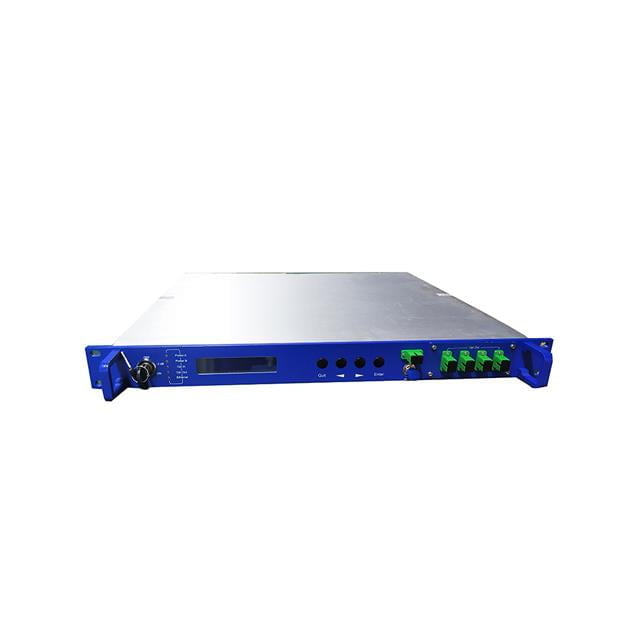Ideal Optical Amplifiers by the Properties
When buying an optical amplifier, what should we consider about besides the price? Of course, it’s the quality. But how can we determine the quality good or not? Then it comes to the properties. There are mainly three aspects to consider about according to the properties of optical amplifiers.
1. Gain, Input Power and Output Power
The most basic property of an optical amplifier is its operating gain, which is the amount by which the input optical signal is amplified. The gain is typically measured in dB, and is in the range of 10 to 30 dB. A gain of 10 dB means the input optical signal is amplified by a factor of 10, while a gain of 30 dB means the input optical signal is amplified by a factor of 1000.
Some amplifiers are designed to operate at a single pre-set gain, while others can support a range of operating gain values, which allows the amplifier to address different applications and functions. Besides gain, an amplifier is also characterized by the range of supported input and output optical powers. In particular, a key specification of the amplifier is the maximum output power which can be supported, also referred to as saturated output power. This parameter is often critical in determining the amplifiers’ cost.
Broadly speaking, optical amplifiers can be classified as either single channel or multi-channel (WDM). As their name implies single channel amplifiers are designed to amplify only a single optical channel, which can be located anywhere within a specified band, such as the C-band (1528 to 1564 nm). Single channel amplifiers, e.g. the C-band EDFA (Erbium Doped Fiber Amplifier), can usually operate over a wide range of operating gains, and require relatively low levels of output power.

In contrast, WDM amplifier is designed to operate when any number of channels (within a specified band) are input to the amplifier. An important property of WDM amplifiers is the gain flatness, which is the variation of the gain for different channels. If the gain is not flat, different WDM channels will have different gain, which can accumulate along a chain of amplifiers leading to a large mismatch between channels at the end of the link.
In order to maintain flat gain, most low-end WDM amplifiers only support a single operating gain, or a relatively narrow gain range. WDM amplifiers providing both flat gain and a large operating gain range require a more complex design. In addition to gain flatness, WDM amplifiers are required to provide a large dynamic input power range, to support different input conditions where any number of channels from 1 to 80 may be present. Additionally, in order to support the maximum amount of channels, WDM amplifiers require a relatively high saturated output power, typically in the range 17 to 23 dBm.
2. Noise
All amplifiers, including optical amplifiers, introduce noise during the amplification process, so that the output signal is always noisier than the input signal. The noise performance of an optical amplifier is characterized by its Noise Figure (NF), which is defined as the ratio of the Signal-to-Noise Ratio (SNR) at the amplifier output to an ideal SNR at the input. Since there is a one-to- one relationship between the NF of an amplifier and the performance of an optical link, it is essential that the NF should be kept as low as possible. The NF depends on the technology used for the amplifier, as well as the gain, with higher gain amplifier usually having lower NF.
3. Dynamic Properties
Another important property of optical amplifiers is their response to dynamic changes in input power. Ideally, the gain of an amplifier should not change at all when the input power changes, however, this is not possible when the amplifier operates at or near the maximum out put power. In this case it is essential that the amplifier respond slowly enough so that its gain is determined only by the average input power, and is not affected by fast changes (for example, due to data modulation).
Amplifiers that respond too fast may be noisy, and do not handle multiple channels well. This is because when there are multiple channels the gain of one channel may change according to whether the other channels have a 0 or 1, an affect known as cross-gain modulation. Even if there is a single high power channel near saturation, then distortion could occur since the 0’s will experience different gain than the 1’s.
On the other hand, even if the amplifier has a slow response, it should also be able to handle sudden long term changes in the average input power. Such sudden changes can occur for example due to channel add/drop (especially in dynamically reconfigurable networks) or protection and restoration switching. In such cases the amplifier may experience large temporary gain variations (known as “transients”) that need to be suppressed as much as possible by the amplifier control mechanism. In the absence of suitable transient suppression, the gain transients could accumulate over a chain of amplifier, leading to large power and/or SNR surges at the receiver.
To summarize, the ideal optical amplifier should support multi-channel operation over as wide as possible a wavelength band, provide flat gain over a large dynamic gain range, have a high saturated output power, low noise, and effective transient suppression. These properties should be achieved while maintaining low power consumption, small size, and low cost. Fortunately, the EDFA technology has advanced to the point where many of these features can be provided simultaneously. Now you know, the ideal optical amplifier is the EDFA amplifier.

